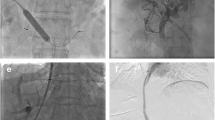Abstract
Two 5.5 French triple-lumen balloon catheters were devised to improve percutaneous transhepatic portal embolization (PTPE) as preoperative management of patients undergoing extensive liver resection. Using these catheters, an ipsilateral approach for embolization is achieved through a portal branch of the liver using fibrin glue mixed with Lipiodol as the embolic material. This approach proved safer and more reliable than the traditional contralateral approach: (1) The portal branch to be resected is punctured; (2) the left and right anterior portal embolization is conducted simultaneously through a single portal puncture; and (3) the catheter sheath can consequentially be removed soon after PTPE without requiring further treatment.
Résumé
On présente deux types de cathéter à ballonnet, de 5.5 F, destinés à améliorer l'embolisation porte préopératoire par voie percutanée transhépatique, en vue d'une résection hépatique étendue. Avec ces cathéters, on peut aborder le foie homolatéral à l'embolisation et Femboliser avec une colle à base de fibrine mélangée à du lipiodol. Cette approche semble plus sûre et fiable que l'approche traditionnelle controlatérale, pour les raisons suivantes: ponction du lobe hépatique et du système porte à réséquer, possibilité d'embolisation simultanée des branches portes antérieures, gauche et droite avec une seule ponction et possibilité d'enlever rapidement la gaine du cathéter après l'embolisation.
Resumen
Dos diferentes catéteres de balón de triple lumen fueron diseñados para mejorar la embolización portal transhepática percutánea como manejo postoperatorio en pacientes sometidos a resecciones hepáticas extensas. Con estos catéteres se logra un aproche ipsilateral para la embolización a través de una rama portal del hígado utilizando pegante de fibrina mezclado con Lipiodol como material embólico. Este aproche, que ha demonstrado ser más seguro y confiable que el aproche contralateral tradicional, se realiza así: primero, se punciona la rama portal que va a ser resecada; segundo, se practica la embolización portal anterior izquierda y derecha simultáneamente a través de punción portal única; tercero, la vaina del catéter puede ser removida sin que sea necesario tratamiento adicional alguno.
Similar content being viewed by others
References
Mizumoto, R., Kawarada, Y., Suzuki, H.: Surgical treatment of hilar carcinoma of the bile duct. Surg. Gynecol. Obstet.162:153, 1986
Bengmark, S., Ekbergh, H., Evander, A., Klofver-Stahl, B., Tranberg, K.G.: Major liver resection for hilar cholangiocarcinoma. Ann. Surg.207:120, 1988
Pichlmayr, R., Ringe, B., Lauchart, W., Bechstein, W.O., Gubernatis, G., Wagner, E.: Radical resection and liver grafting as the two main components of surgical strategy in the treatment of proximal bile duct cancer. World J. Surg.12:68, 1988
Nimura, Y., Hayakawa, N., Kamiya, J., Kondo, S., Shionoya, S.: Hepatic segmentectomy with caudate lobe resection for bile duct carcinoma of the hepatic hilus. World J. Surg.14:535, 1990
Nimura, Y., Hayakawa, N., Kamiya, J., et al.: Hepatopancreatoduodenectomy for advanced carcinoma of the biliary tract. Hepatogastroenterology38:170, 1991
Nimura, Y., Hayakawa, N., Kamiya, J., et al.: Combined portal vein and liver resection for carcinoma of the biliary tract. Br. J. Surg.78:727, 1991
Bismuth, H., Nakache, R., Diamond, T.: Management strategies in resection for hilar cholangiocarcinoma. Ann. Surg.215:31, 1992
Kinoshita, H., Sakai, K., Hirohashi, K., Igawa, S., Yamasaki, O., Kubo, S.: Preoperative portal vein embolization for hepatocellular carcinoma. World J. Surg.10:803, 1986
Makuuchi, M., Thai, B.L., Takayasu, K., et al.: Preoperative portal embolization to increase the safety of major hepatectomy for hilar bile duct carcinoma: a preliminary report. Surgery107:521, 1990
Takada, T., Hanyu, F., Kobayashi, S., Uchida, Y.: Percutaneous transhepatic cholangial drainage: direct approach under fluoroscopic control. J. Surg. Oncol.8:83, 1976
Nagino, M., Hayakawa, N., Nimura, Y., Dohke, M., Kitagawa, S.: Percutaneous transhepatic biliary drainage in patients with malignant biliary obstruction of the hepatic confluence. Hepatogastroenterology39:296, 1992
Nagino, M., Hayakawa, N., Kitagawa, S., et al.: Interventional embolization using fibrin glue for a large inferior mesenteric-caval shunt. Surgery111:580, 1992
Okamoto, E., Kyo, A., Yamanaka, N., Tanaka, N., Kuwata, K.: Prediction of the safe limits of hepatectomy by combined volumetric and functional measurements in patients with impaired hepatic function. Surgery95:586, 1984
Ellman, B.A.: Ablation of renal tumors with absolute ethanol; a new technique. Radiology141:619, 1981
Author information
Authors and Affiliations
Rights and permissions
About this article
Cite this article
Nagino, M., Nimura, Y. & Hayakawa, N. Percutaneous transhepatic portal embolization using newly devised catheters: Preliminary report. World J. Surg. 17, 520–523 (1993). https://doi.org/10.1007/BF01655112
Issue Date:
DOI: https://doi.org/10.1007/BF01655112




